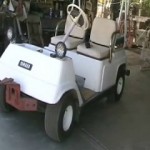 I had pedal to the metal, was moving along nicely when suddenly I started rolling to a stop. The engine was running fine, but there was no go. It was then that I tried to remember a conversation from my brain that I had some 10 to 13 years prior with Bob. It was his old Yamaha Golf Car and I just could not remember what or where he said he did some welding.
I had pedal to the metal, was moving along nicely when suddenly I started rolling to a stop. The engine was running fine, but there was no go. It was then that I tried to remember a conversation from my brain that I had some 10 to 13 years prior with Bob. It was his old Yamaha Golf Car and I just could not remember what or where he said he did some welding.
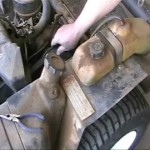 Bob was not available, so I decided to tear into a repair of the cart myself. I was sure that eventually I would find Bob’s repair work somewhere along the trail. I began by removing the engine cover that also serves as the seat and a top. Then I raised the rear of the cart, and placed it firmly on two stands. Before I removed the left side wheel, I found that by spinning it, or the transaxle there was no connection between them. The right side fared no better.
Bob was not available, so I decided to tear into a repair of the cart myself. I was sure that eventually I would find Bob’s repair work somewhere along the trail. I began by removing the engine cover that also serves as the seat and a top. Then I raised the rear of the cart, and placed it firmly on two stands. Before I removed the left side wheel, I found that by spinning it, or the transaxle there was no connection between them. The right side fared no better.
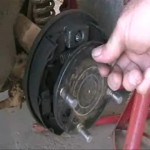 After removing the wheel and brake drum, I was able to spin the axle easily and I noticed a grinding noise. Was the noise coming from the bearing or was the axle broken? My answer came after loosening four bolts that held a plate-brake drum
After removing the wheel and brake drum, I was able to spin the axle easily and I noticed a grinding noise. Was the noise coming from the bearing or was the axle broken? My answer came after loosening four bolts that held a plate-brake drum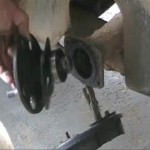 combination to the axle housing. Once loose the whole assembly just fell off into my hands. Alas, the axle was broken, Bob’s repair was visible, and I was thankful that the transaxle was not the culprit.
combination to the axle housing. Once loose the whole assembly just fell off into my hands. Alas, the axle was broken, Bob’s repair was visible, and I was thankful that the transaxle was not the culprit.
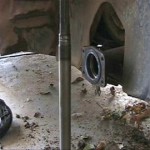 I found a replacement axle, housing, and brake assembly at an online auction and now I could begin my repair. I decided not to use the old axle housing, as the spot where the bearing fit was a bit rough. It was not a race in a true sense as the axle bearing is a sealed unit that fits into the housing cutout. I then removed the old housing, installed the replacement housing, and then installed the brake assembly and axle.
I found a replacement axle, housing, and brake assembly at an online auction and now I could begin my repair. I decided not to use the old axle housing, as the spot where the bearing fit was a bit rough. It was not a race in a true sense as the axle bearing is a sealed unit that fits into the housing cutout. I then removed the old housing, installed the replacement housing, and then installed the brake assembly and axle.
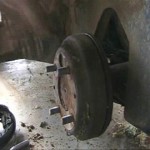 I did have to loosen the tensioner near the brake pedal to have enough cable to hook up to the replacement brake assembly. I was now able to re-install the tire, lower the cart, and re-install the top cover seat assembly. It was time for a test drive!
I did have to loosen the tensioner near the brake pedal to have enough cable to hook up to the replacement brake assembly. I was now able to re-install the tire, lower the cart, and re-install the top cover seat assembly. It was time for a test drive!

